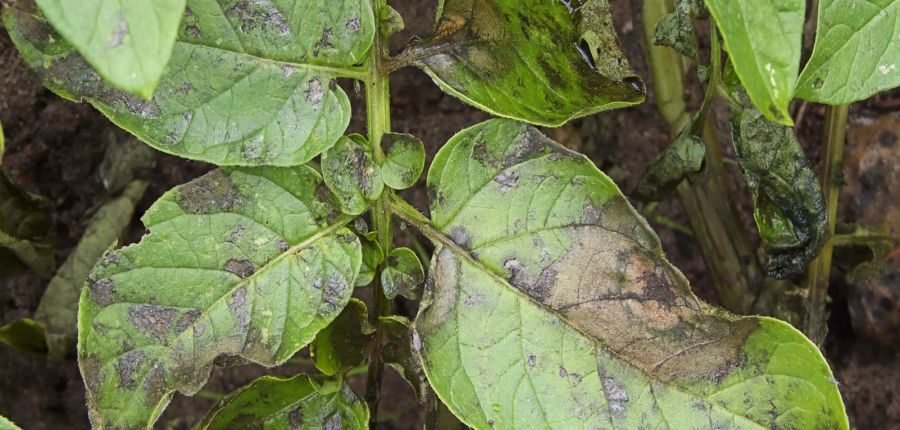Blight - the dread of vegetable gardeners
Posted By: rocket veg Category: Pests and Diseases, Seasonal AdviceBlight. The very word is enough to strike fear into the heart of the most seasoned of vegetable gardeners! In case you don’t know already, blight is a disease which affects potatoes and tomatoes and is therefore referred to as ‘potato and tomato blight’, sometimes ‘late blight’ as it tends to strike later in the summer. It’s a serious disease, caused by a fungus-like organism whose spores are spread by the wind and is especially prevalent during warm, damp weather following a dry, sunny spell. Blight first shows on the foliage of the plants in the form of dark brown spots and if left unchecked, the disease will spread to the potato tubers and tomato fruits and your crop will be ruined. It stands to reason that tomatoes grown in a greenhouse are less likely to be affected if blight is present.
Blight in potatoes
Recognising blight on potato plants can be tricky as it usually strikes when the plants are beginning to die off and the foliage is discolouring. It first shows as brown spots which rapidly widen to form larger dark patches, at which point the leaves will shrivel and collapse. If the weather conditions are especially wet, look for a fine white mould surrounding the dark rings on the underside of the leaves. Once blight affects the plant stem, it will rapidly spread to the root system and tubers (ie. your potatoes!), showing as dark decay under the skin. If you suspect that your potatoes have been affected by blight, always check the spuds on a regular basis once they have been lifted and put to store as any bacteria will quickly spread and cause the potatoes to rot, giving off a memorably unpleasant smell!
Blight in tomatoes
Look for similar signs as for potatoes – brown patches on the leaves and then the plant stem. Once affected, any unripe tomatoes will have brownish marks on their green skin, while ripe tomatoes will quickly rot and fall from the plant, a distressing sight.
Preventing and controlling blight
In spite of what you may hear from other gardeners, there are no effective remedies for preventing blight attacking your potatoes and tomatoes but it is possible to receive special warnings, linked to local weather conditions when blight is likely to be present in the area. Some gardeners resort to throwing a covering of fleece over potatoes and tomato plants in the hope that it will keep the disease at bay. At the first sign of blight-affected plants, picking off all the affected leaves may deter the spread of the disease but won’t eradicate it completely. Once it spreads to the stems of potato plants, cut the stems off close to the soil and remove all traces of the foliage (haulms); the tubers can be harvested a few weeks later once their skin has hardened off and with luck, they won’t have been affected.
Early crops of potatoes are unlikely to be affected, but if blight is present in the area, covering the young foliage with soil (‘earthing up’) may reduce the chance of it affecting the developing plants.
Ideally, all plant matter affected by blight should be burned. If this is not possible, bury the material at least 45cm (18”) or consign it to a green waste collection. Be sure to practice rotation of crops
Blight-resistant varieties of potatoes and tomatoes
There are a few varieties of potato which are claimed to offer some resistance to blight, the ‘Sarpo’ family being one example. However, recent research into blight indicates that there is a new, dominant strain which is capable of overcoming any gene resistance in plants. When choosing seed potatoes in early spring, be aware that some of the old favourites, such as ‘King Edward’ and ‘Arran Pilot’ are particularly susceptible to blight.
As for tomatoes, there are one or two varieties which are claimed to be blight resistant, but even these will eventually be affected if weather conditions are right and blight spores are present.
As you will have gathered, blight is a story of gloom and doom, so I hope your crops don’t succumb.







